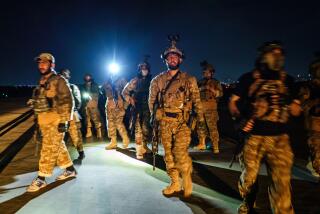Bowe Bergdahl’s captors: Who, where and why?
- Share via
Reporting from Washington — The armed Taliban fighters who captured Bowe Bergdahl in southeastern Afghanistan on June 30, 2009, quickly handed him to a far more dangerous group that shuttled him between hide-outs in Pakistan’s rugged tribal belt for the next five years.
For much of that time, CIA drones trolled the skies overhead, searching for signs of the missing U.S. soldier. Until late last year, the drones fired missiles that killed hundreds of fighters and at least one senior leader of the militant group, known as the Haqqani network.
A five-month halt in the CIA drone strikes this year coincided with intensifying efforts to get Bergdahl out. His return on May 31 has freed the CIA to resume the attacks, and on Wednesday and Thursday, drones hit targets in the tribal area known as North Waziristan, where the Haqqani group is based, killing 16 militants.
U.S. officials believe the Haqqani network ultimately agreed to release Bergdahl in an exchange for five Taliban detainees from the U.S. military prison at Guantanamo Bay, Cuba, in part because one of the five was Mohammad Nabi Omari, a relatively low-ranking Taliban official but a Haqqani associate.
The story of Bergdahl’s captivity, and the hunt for him, is far more complex than has emerged to date. The new details raise questions about how much U.S. intelligence agencies knew of his location when they were firing drones, whether rescue attempts were ever possible, and whether Pakistan’s intelligence agency, which U.S. officials say has close ties to the Haqqani group, helped or hindered his ultimate release.
Bergdahl was admitted early Friday to Brooke Army Medical Center in San Antonio after two weeks at a U.S. military hospital in Germany. He remains in the military and it’s unclear whether he will speak publicly about his ordeal.
According to Pakistani sources close to the Haqqani network, Bergdahl was taken to North Waziristan only a few days after he wandered off Outpost Mest Malak in Afghanistan’s Paktika province. An unconfirmed report given to U.S. special operations forces said local Taliban fighters gave or sold the American to a timber merchant who then smuggled him across the border.
Bergdahl was moved at “very frequent intervals” in Pakistan, often between hide-outs in the Shawal Valley, close to the Afghan border, according to an individual with close contacts to the Haqqani network.
“He was kept as a precious treasure,” the individual said, speaking on condition of anonymity for his safety.
The sources said Bergdahl was hidden in Miram Shah, a market town that is the capital of North Waziristan, for an extended period but spent most of his captivity in heavily forested areas.
U.S. officials confirmed that Bergdahl was held in a small cell or metal cage for several weeks after he tried to escape. One report passed to the U.S. military said that he had been found cold and hungry, hiding in a ditch, after five days on the run in June 2010.
By multiple accounts, Bergdahl was under the control of Mullah Sangeen Zadran, one of the most influential commanders in the Haqqani network.
Sangeen was a top deputy to Sirajuddin Haqqani, who hailed from the same Zadran tribe and who now heads the extremist network founded by his late father, Jalaluddin Haqqani. But Sangeen also had close ties to other insurgent leaders on both sides of the border, making him well suited to watch over the sole U.S. prisoner of war.
Haqqani, whose militant faction frequently intersects with the Pakistani Taliban in the roiling mix of Islamist militant groups, also took a personal interest in Bergdahl.
“The Taliban knew that Bergdahl was their goose that laid the golden egg,” said another individual with links to the group in Miram Shah. “That is why the Taliban, especially Siraj Haqqani, was taking care of the American soldier.”
In August 2011, two years after Bergdahl disappeared, the State Department added Sangeen to its list of global terrorists. He was described as a senior Haqqani lieutenant who had “orchestrated the kidnappings of Afghans and foreign nationals” in the border region.
In September 2012, the State Department also named the Haqqani network as a foreign terrorist organization.
Sangeen was killed by a CIA drone strike Sept. 6 in the Ghulam Khan area of North Waziristan, according to the independent FATA Research Center in Islamabad, Pakistan, which tracks militant groups in the country’s Federally Administered Tribal Areas.
The successful drone strike raised fears in the White House and Pentagon that one of Bergdahl’s guards might try to kill him in revenge. It’s unclear who took charge of Bergdahl after Sangeen’s death.
Although it is closely aligned with Taliban movements in Afghanistan and Pakistan, the Haqqani group is an independent network of experienced fighters. It has been blamed for some of the boldest attacks on U.S. and coalition forces in Afghanistan, including a daylong siege of the U.S. Embassy in Kabul in September 2011.
U.S. officials have repeatedly accused Pakistan’s spy agency, Inter-Services Intelligence, of supporting the Haqqani network, including organizing the U.S. Embassy attack. Pakistan denies the allegations.
Unlike the Afghan Taliban, which has not targeted Americans outside Afghanistan, Haqqani leaders have sought to launch attacks on the U.S. homeland.
In the most dramatic case, U.S. intelligence officials linked Faisal Shahzad, a Pakistani American who attempted to set off a massive car bomb in New York’s Times Square in May 2010, to the Haqqani network and the Pakistani Taliban, known as Tehrik-i-Taliban, or TTP. The plot fizzled only because the homemade bomb failed to explode.
Bergdahl was captured at a pivotal time in the U.S. counter-terrorism battle against the Haqqani network. In August 2009, just over a month after Bergdahl disappeared, a CIA drone attack killed Baitullah Mehsud, a TTP leader with close ties to Sangeen and the Haqqani network.
Four months later, a suicide bomber blew himself up on a CIA base in eastern Afghanistan that helped direct drone strikes against Haqqani targets across the border. Among those killed were seven American CIA officers and contractors, the highest CIA toll in 25 years.
The TTP claimed responsibility and said the attack was in retaliation for the drone strike that killed Mehsud.
The U.S. search for Bergdahl, and his ultimate release, involved an array of U.S. and foreign military and intelligence agencies.
It also included a private intelligence outfit called the Eclipse Group that was run by a former top CIA operations officer, Duane “Dewey” Clarridge.
In 1991, Clarridge was indicted on seven counts of perjury in the Iran-Contra scandal but was pardoned by President George H.W. Bush before his trial was over. He has said he maintained a network of spies and informants in Afghanistan and Pakistan after he left the CIA.
A former Eclipse member said the group paid local informants to collect intelligence, which was passed on to U.S. military commanders searching for Bergdahl. The group said it had access to informants in the Taliban and the Haqqani network, including one of Bergdahl’s jailers.
A former senior U.S. military officer involved in the hunt for Bergdahl said the Eclipse reports contained both rumors and fact.
Some of the information checked out, the former officer said. But other tips, including reported locations for Bergdahl, did not, he said.
But he said U.S. special operations commanders searching for Bergdahl wanted to keep receiving the reports.
“We take everything we can get,” he said.
A 56-page file of Eclipse intelligence reports from July 2009 to August 2012 claimed that Bergdahl was high on marijuana when he was captured. The former officer said U.S. military officials believed Bergdahl had smoked marijuana the night he walked off his outpost five years ago.
A Pentagon spokesman declined to comment on the Eclipse reports. Clarridge, reached at his home in Leesburg, Va., also declined to discuss his group’s reports.
“Not worth it,’’ he said.
Zucchino reported from Durham, N.C., Cloud from Washington and Bengali from Mumbai, India. Special correspondents Aoun Sahi in Islamabad, Zulfiqar Ali in Peshawar, Pakistan, and Hashmat Baktash in Kabul, Afghanistan, contributed to this report.
More to Read
Sign up for Essential California
The most important California stories and recommendations in your inbox every morning.
You may occasionally receive promotional content from the Los Angeles Times.













